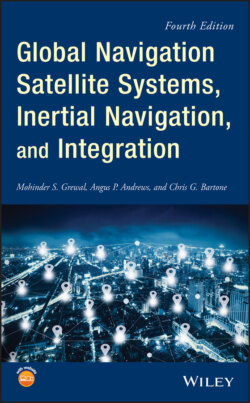Читать книгу Global Navigation Satellite Systems, Inertial Navigation, and Integration - Mohinder S. Grewal - Страница 96
Compensation
ОглавлениеIn this case, calibration amounts to estimating the values of and , given input–output pairs , where is known from controlled calibration conditions and is recorded under these conditions. For accelerometers, controlled conditions may include the direction and magnitude of gravity, conditions on a shake table, or those on a centrifuge. For gyroscopes, controlled conditions may include the relative direction of the rotation axis of Earth (e.g. with sensors mounted on a two‐axis indexed rotary table), or controlled conditions on a rate table.
The full set of input–output pairs under sets of calibration conditions yields a system of linear equations
(3.5)
in the unknown parameters (the elements of the matrix ) and 3 unknown parameters (rows of the 3‐vector ), which will be overdetermined for . In that case, the system of linear equations may be solvable for the calibration parameters by using the method of least‐squares,
(3.6)
provided that the matrix is nonsingular.
The values of and determined in this way are called calibration parameters.
Estimation of the calibration parameters can also be done using Kalman filtering, a by‐product of which would be the covariance matrix of calibration parameter uncertainty. This covariance matrix is also useful in modeling system‐level performance.
